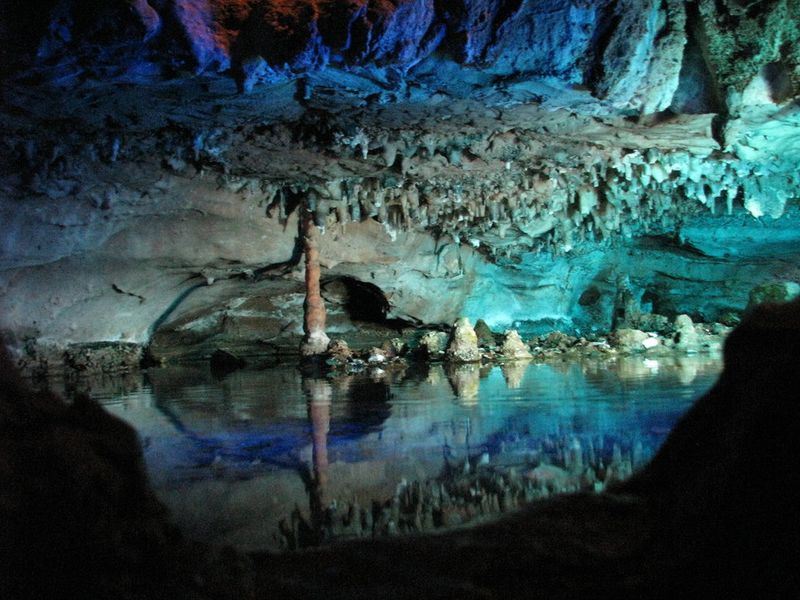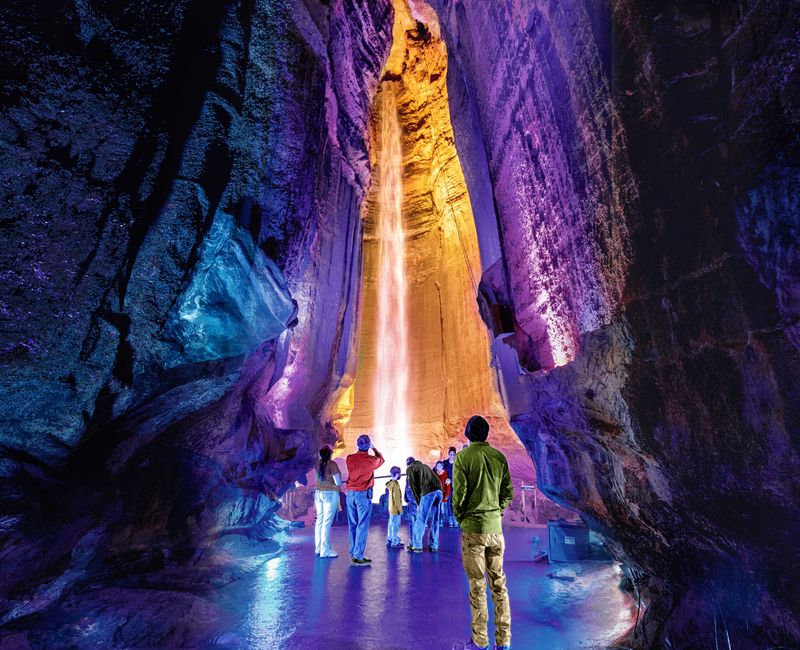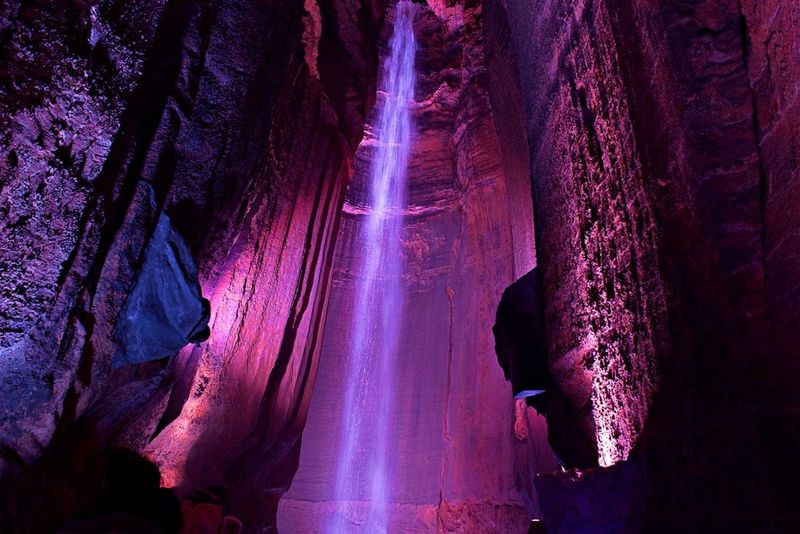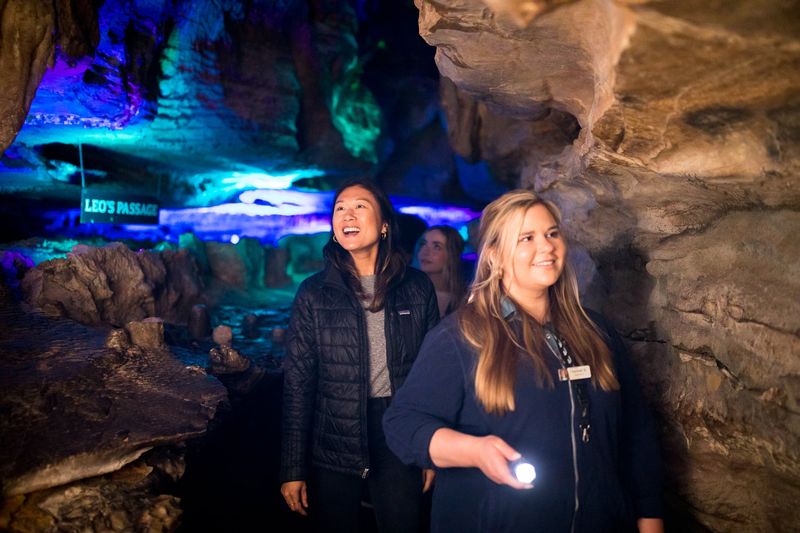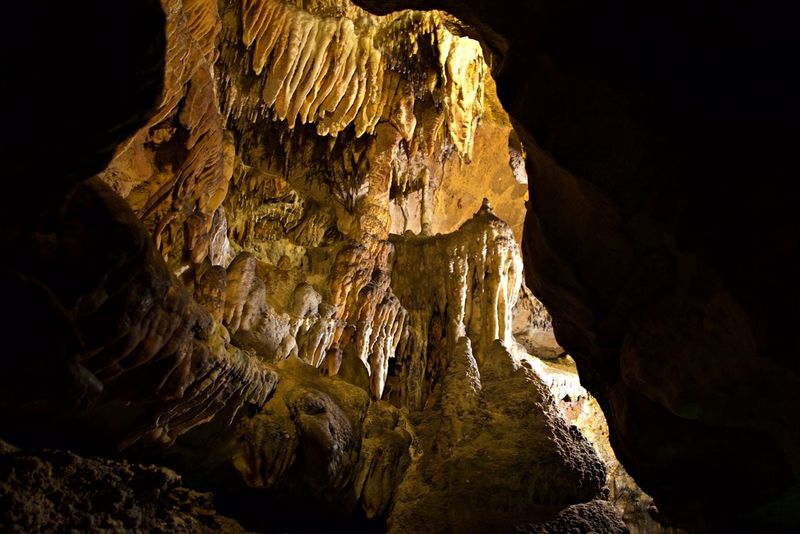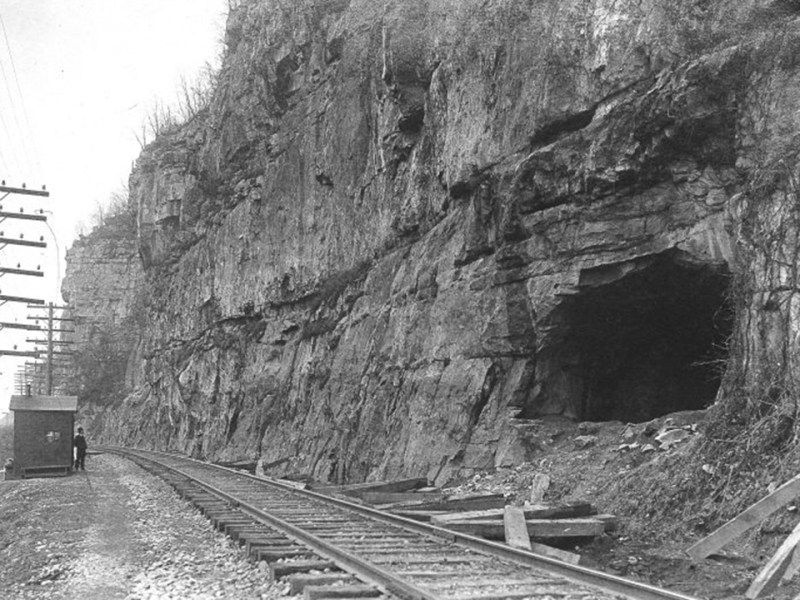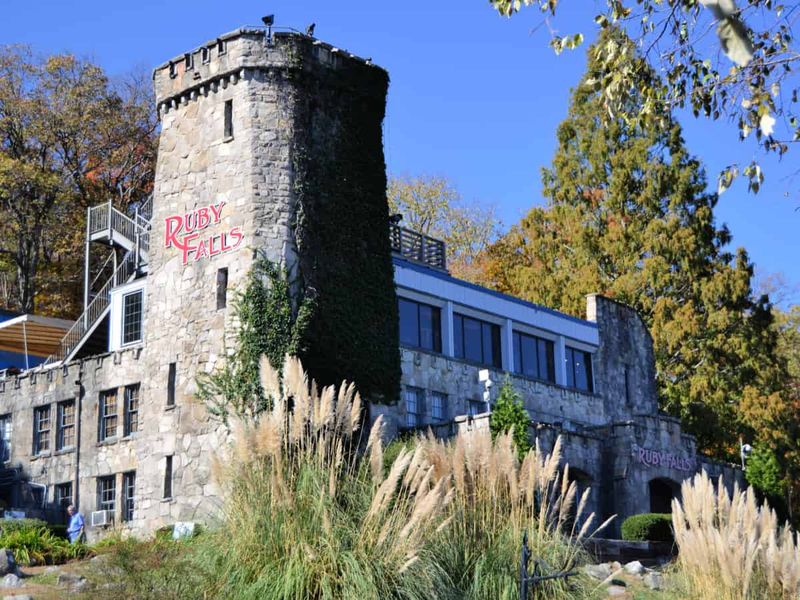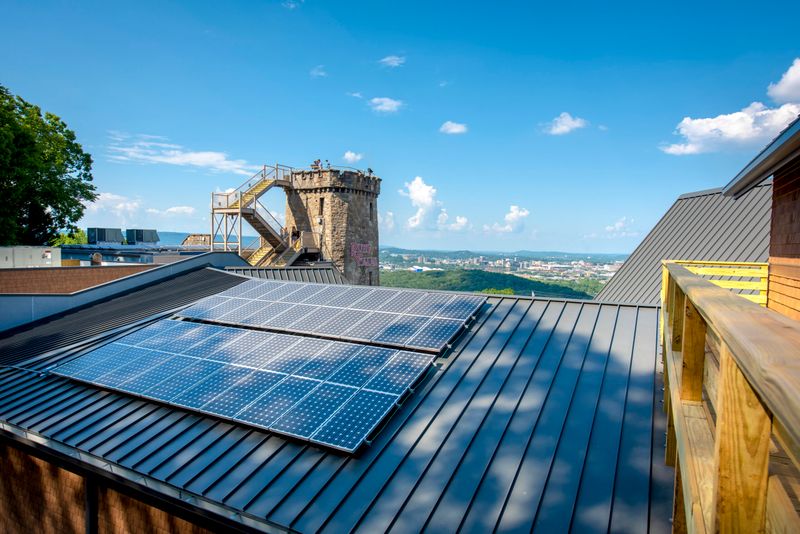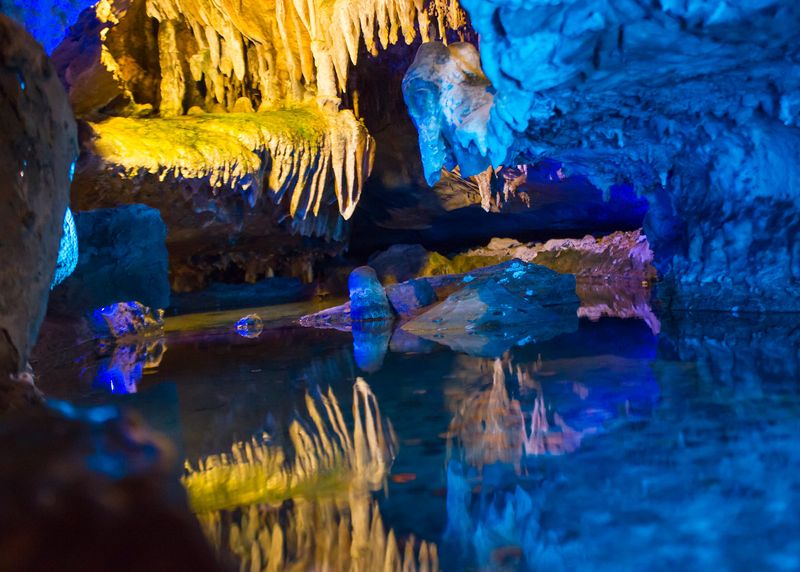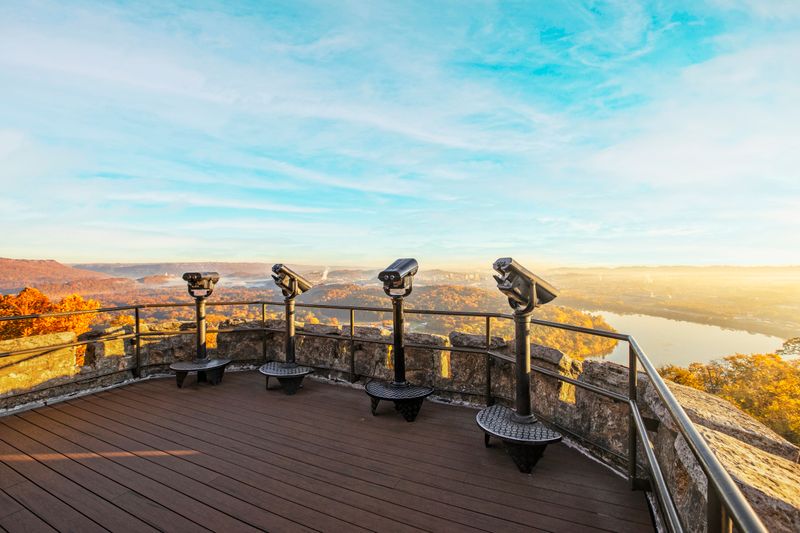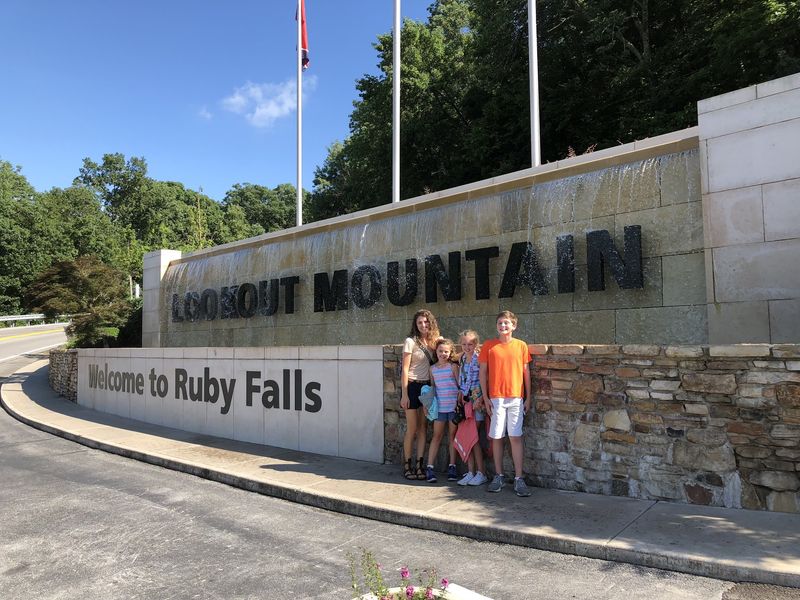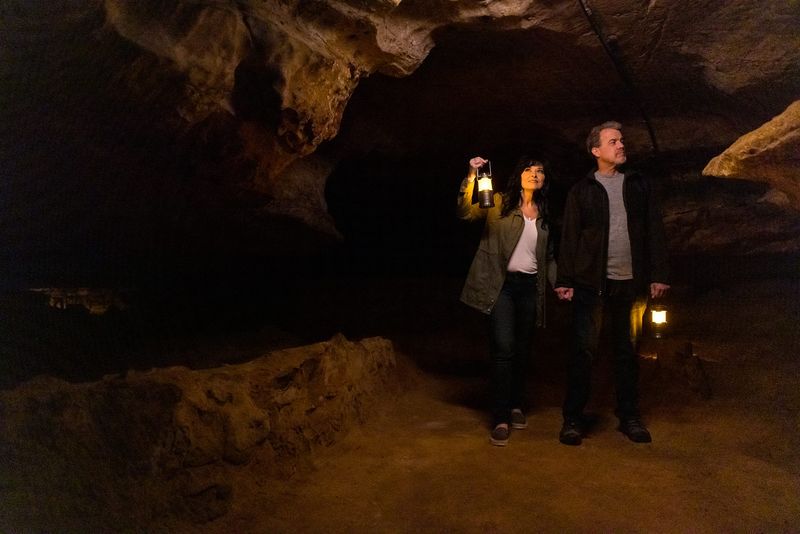Beneath Lookout Mountain, a thunderous ribbon of water plunges through darkness, revealing one of America’s most unforgettable underground spectacles. Ruby Falls blends raw geology, pioneering history, and theatrical storytelling into a cave adventure unlike any other. From elevator descents to color-drenched cascades, every turn promises awe. Ready to descend a thousand feet and meet the waterfall that redefined subterranean wonder?
1. Hidden Deep Inside the Mountain
Ruby Falls sits hidden more than 1,000 feet under Lookout Mountain in Tennessee, a secret world sculpted by moving water and time. Visitors descend into an otherworldly realm where dripping stone, resonant echoes, and cool air reset your senses. The concealment heightens anticipation: each corridor bends toward a grand reveal. Being so deep underground underscores the sheer improbability of the waterfall’s discovery and continued accessibility. This isolation preserves an ambience both mysterious and intimate. You feel the mountain’s weight above and the Earth’s patient artistry around you. Few places compress wonder, depth, and stillness so completely.
2. Tallest Underground Waterfall Open to the Public in the U.S.
Ruby Falls is celebrated as one of the tallest subterranean waterfalls accessible to visitors in the United States, with a dramatic drop around 145 feet. Sources sometimes cite a shorter measure, but the spectacle remains breathtaking regardless of numerical debate. The sightline stretches upward through a stone shaft as water ribbons down in perpetual motion. Visitors witness gravity, geology, and hydrology on grand display. The thunder of falling water reverberates through the chamber, vibrating in your chest. It’s a rare combination of scale, accessibility, and atmosphere. Standing near the plunge, you sense both primal energy and delicate beauty.
3. Discovered by Accident in 1928
In 1928, explorer and entrepreneur Leo Lambert stumbled upon Ruby Falls while drilling an elevator shaft for a different cave attraction. The breakthrough revealed a passage leading to a hidden waterfall chamber, transforming a routine engineering project into a landmark discovery. This moment of serendipity reshaped Chattanooga’s tourism and inspired generations of cave explorers. Accidents rarely yield such enduring wonders. The narrative imbues every tour with suspense: a story of curiosity meeting chance. From industrial effort to natural revelation, Ruby Falls embodies how exploration often rewards risk-takers. Visitors today trace Lambert’s footsteps into a discovery still unfolding.
4. Named for His Wife
Leo Lambert named the waterfall for his wife, Ruby, forever entwining a personal love story with a natural marvel. The naming adds warmth to stone and water, humanizing the grandeur with affection. Guests feel that intimacy upon arrival; the falls aren’t merely geological, they’re sentimental. In a rugged chamber, the name introduces elegance and tenderness. Stories anchor places in memory, and this one lends the destination an enduring identity. The result is a site that resonates both romantically and historically. Ruby’s namesake glows in visitors’ recollections like a jewel, transforming a cave into an emblem of devotion.
5. Elevator Ride to the Depths
The journey begins with an elevator that drops you swiftly into the mountain’s interior. Some tours use a glass-front design, framing the geology as you descend. That first motion changes everything – sound dampens, temperature cools, and anticipation spikes. It’s a theatrical cue: the surface world is gone, the cave awaits. This elevator is an act-one curtain rise, setting a tempo of discovery. It also democratizes access, inviting travelers of varied abilities to enter a realm once reserved for cavers. The vertical transit dramatizes depth itself, making every step that follows feel earned and exhilarating.
6. Ancient Limestone Formations
Ruby Falls showcases classic limestone artistry: stalactites taper from ceilings, stalagmites rise in patient columns, and flowstone drapes carve frozen waves. Water – loaded with dissolved minerals – did the sculpting over immense spans of time. The formations read like a geological library, each layer documenting seasons, chemistry, and past climates. Visitors learn the difference between dripping-sculpted features and sheet-flow patterns. The cave’s palette of creams, ambers, and grays glows under guided lighting. These structures still grow, molecule by molecule, reminding us geology never sleeps. In a single corridor, you witness nature’s slow choreography, set to the metronome of dripping calcite.
7. A Dramatic Tour Experience
The Ruby Falls tour is crafted like a stage play, building tension through narrowing passages and crescendoing sound. Guides illuminate formations and lore, then lead you into the waterfall chamber for a dramatic reveal enhanced by lighting. Colors ripple across mist as water thunders, and conversations fall quiet. The choreography turns a cave walk into an immersive spectacle. It’s not just seeing; it’s feeling timing, light, and resonance. The tour balances education and emotion, leaving room for personal reflection. By treating nature as the star and visitors as audience, Ruby Falls transforms geology into a shared, unforgettable performance.
8. Historical Role as a Fallout Shelter
During the 1960s, parts of Ruby Falls were designated a civil-defense fallout shelter, a stark reminder of Cold War anxieties. The mountain’s mass offered protective potential, and the underground spaces were cataloged for emergency use. This chapter adds a surprising social history layer to a natural wonder. Visitors standing amid draperies and columns can imagine a very different purpose for the passages. The juxtaposition is striking: sanctuary from fallout versus sanctuary for awe. Exhibits and storytelling occasionally reference this era, grounding the attraction in broader American history. It’s a window into how communities adapt extraordinary sites for survival.
9. Above-Ground Castle Entrance
Before going underground, guests encounter a limestone “castle” built around 1929 that serves as the attraction’s iconic entrance. The architecture adds historic charm and telegraphs the experience: this is a portal to another realm. Its turrets and stonework evoke a storybook mood, perfect for photos and pre-tour orientation. Inside, amenities and exhibits prepare visitors for descent. The building anchors Ruby Falls within Chattanooga’s heritage, bridging city and cave. As you step from bright mountain vistas into the cool interior, the castle marks a threshold. It’s equal parts welcome center, time capsule, and symbol of enduring hospitality.
10. Constant Cool Temperature
Ruby Falls keeps a steady temperature near 60°F (about 15°C), offering relief from Southern summers and calm during winter. The rock mass buffers seasonal swings, making the cave feel like natural climate control. Guides recommend light layers for comfort. This consistency enhances the sensory experience: cool air, faint mineral scent, and the sound of distant water. It also supports the stability of formations and ecosystems. In a world of fluctuating forecasts, the cave remains reassuringly constant. That predictability makes planning easy and the visit comfortable, whether you arrive under blazing sun or a brisk December sky.
11. Significant for Sustainable Tourism
Ruby Falls was the first U.S. attraction to achieve Green Globe certification, reflecting rigorous sustainability practices. Initiatives span energy efficiency, waste reduction, and educational outreach. Solar arrays offset carbon, while EV charging encourages cleaner travel. Stewardship extends underground, where careful lighting and visitor flow protect delicate formations. The team publishes goals and progress, inviting guests to join the effort. Sustainability isn’t a side note; it’s woven into operations and storytelling. Visitors leave with both memories and models for responsible tourism. In marrying conservation with spectacle, Ruby Falls charts a path for attractions balancing impact and inspiration.
12. Early Visitor Attraction
Public tours at Ruby Falls began around 1930, remarkably soon after the 1928 discovery. During the Great Depression, the site offered work, wonder, and an affordable escape. Early visitors navigated less-developed pathways, helping shape the modern route through feedback and fascination. Historic photos reveal lantern-lit excursions and pioneering guides. The attraction grew with Chattanooga, becoming a regional rite of passage. Its continuity through economic shifts underscores the site’s resilience. Today’s polished experience honors those first tours, preserving heritage while enhancing safety and storytelling. You’re part of a tradition nearly a century strong.
13. Dramatic Geological Time Scale
The limestone of Lookout Mountain dates to the Carboniferous period – hundreds of millions of years old. During that time, shallow seas laid down carbonate sediments later transformed into rock. Groundwater carved passages, enlarged fractures, and created the waterfall’s path. Standing within the chamber, you’re literally inside an ancient seafloor, repurposed by geologic forces. The immense timescale humbles the timeline of human history. Every drip you hear echoes eons of change. Guides translate these epochs into approachable stories, making Earth history tangible. Ruby Falls compresses deep time into a walkable museum, where each layer whispers an origin story.
14. A Hidden World Beneath the Surface
Descending into Ruby Falls feels like slipping into a secret chapter of the planet. Passages twist and narrow, amplifying echoes and curiosity. The faint roar grows as you approach the waterfall chamber, building suspense step by step. The darkness clarifies perception: details pop, textures matter, footsteps resonate. It’s an embodied experience dominated by temperature, sound, and subtle light. The cave shelters a microcosm where time stretches and focus sharpens. Even seasoned travelers feel a childlike thrill. It’s the rare attraction that invites introspection while delivering spectacle – an immersion into Earth’s quiet, hidden theater.
15. Family-Friendly Yet Adventure-Filled
Ruby Falls strikes a careful balance: accessible pathways and guided pacing welcome families, yet the environment remains thrilling. Kids marvel at the waterfall reveal; adults savor the geology and history. The adventure feels authentic – darkness, echo, mist – without the technical demands of wild caving. Clear signage and attentive guides keep the outing smooth. It’s a shared narrative where everyone finds a favorite moment, from elevator drop to finale. The result is a rare crossover attraction: memorable to children, grandparents, and avid travelers alike. You leave feeling braver, wiser, and bonded by a journey undertaken together.
16. Unique Natural Lighting Effects
The lighting at Ruby Falls transforms mist and stone into living sculpture. Programmable colors trace the water’s movement, while carefully placed fixtures reveal textures without overwhelming them. The result is a dynamic interplay of shadow and hue that heightens emotion. In photos, the falls appear otherworldly; in person, they feel cinematic. Lighting designers balance artistry with conservation, limiting heat and algae growth. The choreography of light guides attention, punctuating the reveal with a crescendo. It’s a masterclass in augmenting nature without replacing it – an atmospheric lift that makes the unforgettable even more indelible.
17. Above-Cave Activities Too
Ruby Falls extends beyond the cave with scenic overlooks that frame the Tennessee River and surrounding valleys. The mountaintop setting encourages lingering for photos, picnics, and sky-watching. Nearby adventures – from ziplines to trails – round out a full-day itinerary. This context elevates the destination from singular sight to multi-layered experience. You can pair underground awe with open-air vistas, letting light and shadow balance your senses. For travelers short on time, the overlooks provide instant payoff. For planners, they create flexibility and flow between activities. It’s a holistic mountain outing, not just a cave stop.
18. It’s also a Valid Educator’s Site
Ruby Falls excels as an educational venue, linking geology, hydrology, cave ecology, and regional history. Guides translate complex topics into memorable moments – spotting stalactite growth tips, discussing aquifers, or tracing rock ages. School groups find standards-aligned content and tactile learning. Adults appreciate context that deepens wonder. Exhibits highlight conservation ethics and human impact underground. Even logistics become lessons in safe exploration and accessibility. The cave converts abstract Earth science into sensory experience, reinforcing classroom learning with echoes, textures, and cool air. Educators leave with students engaged and inspired, their curiosity sparked for further inquiry.
19. Constant Innovation and Accessibility
Beyond its history, Ruby Falls continually upgrades for accessibility, sustainability, and guest comfort. EV charging stations, energy-efficient systems, and improved wayfinding reflect a forward-looking ethos. Ramps, railings, and thoughtful pacing broaden who can enjoy the cave safely. These investments protect fragile environments while elevating the visitor experience. Innovation isn’t flashy here; it’s practical and people-centered. By marrying heritage with improvement, Ruby Falls stays relevant across generations. The effect is a destination that welcomes more travelers with fewer barriers, ensuring the waterfall’s magic reaches wider audiences responsibly and reliably.
20. Special Events and Seasonal Magic
Throughout the year, Ruby Falls hosts seasonal events that recast the cave and mountaintop in fresh moods. Holiday illuminations, themed tours, and romantic evenings add new lenses to familiar spaces. These programming layers maintain excitement for return visitors and locals. They also showcase the site’s versatility – equally suited for contemplation, celebration, or connection. With careful planning, events respect conservation limits while enhancing atmosphere. It’s a reminder that great attractions can be renewed without altering their essence. The waterfall remains the star; events simply change the soundtrack, inviting you to experience the wonder again.
21. A Blend of Nature, History & Tourism
Ruby Falls thrives where geology, human ingenuity, and hospitality converge. The waterfall’s raw power meets careful engineering and polished storytelling, yielding an experience deeper than a single spectacle. History is palpable – from accidental discovery to Depression-era tours – yet the site remains forward-looking through sustainability. Visitors arrive for a view and leave with a narrative. It’s a destination that rewards curiosity, photography, and reflection. In a crowded travel landscape, Ruby Falls feels singular: a place where the Earth’s interior becomes a stage and every visitor, a witness. That synthesis is its lasting magic – and the reason to go now.


